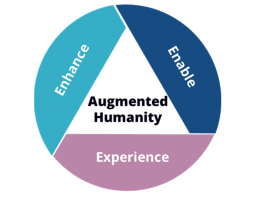There are ongoing debates about what the “next normal” office space will look like and how technology will enhance and augment human capabilities over the coming years. Arming employees with wearables for proximity monitoring, deploying a fleet of robotic space cleaners, using traditional touchless fixtures and creating individual climate zones are all under the spotlight in the IT industry.
For example, expanding the size of personal workspaces and leveraging infrared sensors together with AI facial recognition can create the perfect personalised temperature. Imagine your office taking advantage of this to enhance employee productivity.
Studies have shown us that:
- Employees perform mental tasks better at temperatures slightly below their comfort zones
- Those comfort zones are highly individual and there is no one-range-fits-all
Enhancing human capabilities and performance would be one potential area that businesses can tackle with a technological solution based on biofeedback — or simply allowing your body’s surface temperature to regulate the environment around you.
Why Augmented Humanity?
You may already be familiar with IDC’s augmented-humanity (AH) research, but as a refresher: we conceptualise human-augmentation technology into three pillars: enable, enhance and experience. Earlier this year, IDC research analyst Giulia Besana looked at the importance of enabling technology that fosters inclusion and improves accessibility.
Now let’s take a closer look at how technology can enhance and extend human skills and abilities and enable us to do things better, faster and with greater efficiency and precision.
Why Is it Relevant?
Employee productivity and motivation are impacted by a number of factors, including the difficulty of performing manual tasks, the temperature of office buildings, and technology for accessibility and ease of collaboration. IDC’s Future of Work research reveals that employee experience must become a key factor in workplace environments to promote better talent retention, which in turn builds organisational resilience.
Enhance: Extending the Self Through Technology
The enhance dimension answers the question of how technology can help humans do things better, faster, easier, safer and with greater efficiency and precision. It focuses on solutions that enhance human skills and abilities by boosting performance and productivity while minimising risk:
Memory
Similar to the intelligent climate zone example, technology originally developed for a specific purpose can be adapted to serve multiple purposes and create additional value. Accessibility solutions created for people with impaired eyesight, for example, can be adapted to facilitate face-to-face business communication.
Acting as a personal assistant, OrCam’s MyMe leverages the company’s artificial vision platform to deliver real-time insights on every person encountered throughout the day. By synching with contact databases (such as phonebook, Outlook and LinkedIn), it can display useful information on a wearable device (such as a smart watch) — the name of the person, for example, when you last met that person and what you talked about.
This type of solution could particularly benefit C-suite executives, PR professionals, sales executives or anyone whose job requires them to meet with a wide range of people every day.
Strength
Prolonged physical exertion at work could lead not only to employee dissatisfaction but also to physical injury. Employees’ physical and mental well-being is high on the agenda for businesses, which explains why there is such strong demand for these solutions.
There is already a variety of robotic exoskeletons on the market to reinforce human abilities and improve strength and endurance. Some companies have already implemented these on their factory floors. Ford and BMW, for example, allow employees equipped with exoskeleton suits to perform strenuous tasks to increase efficiency and prevent injuries.
Speed
Workers in large warehouses often carry around a tablet or a checklist for directions, to access items and quantities, or to update stock availability. This is a manual process and it is prone to errors.
In one of its distribution centres in Greece, Coca-Cola equipped pickers with AR smart glasses, which provide real-time guidance, instructions and quantities. A camera on the glasses acts as a scanner and automatically performs updates to products once the item QR codes are scanned. The solution not only improved accuracy but also enhanced performance speed.
The technology itself has a range of applications outside the fast-moving consumer goods (FMCG) field, such as machinery operation and specialist-guided maintenance and repair.
What we are witnessing now are the early days of the implementation of AH technology. Early adopters lead the way, but wider market penetration is needed to assess the impact of the solutions. It’s not difficult, however, to see the huge potential of technology as a means to enhance human abilities.
To find out more about IDC’s augmented-humanity research, contact Galina Spasova.


